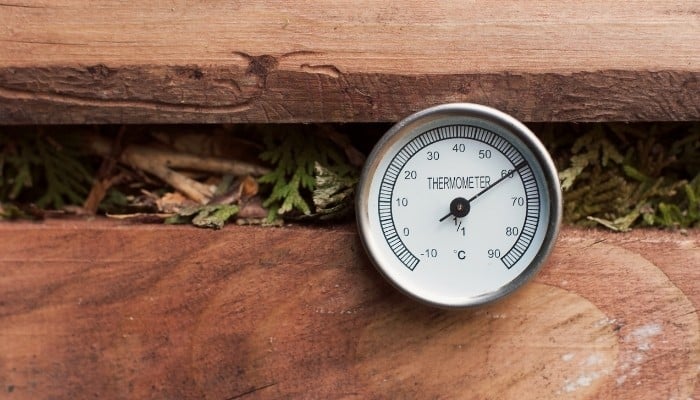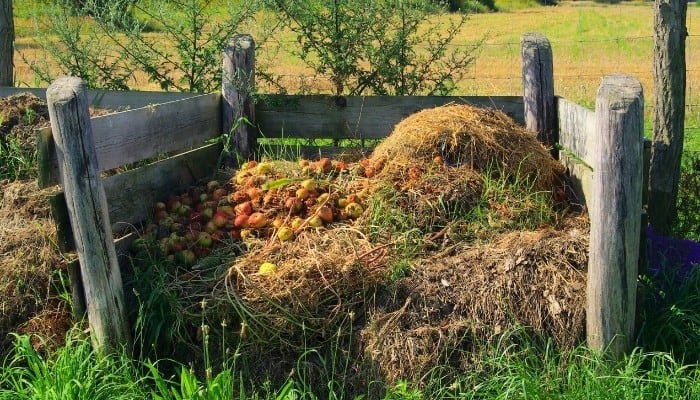When we compost at home, our aim is typically to establish conditions conducive to aerobic composting. Essentially, we need to ensure that there is sufficient oxygen integrated into the mix.
We can achieve this by turning the mix regularly by hand, by using a compost tumblers, or simply by composing a composting system in such a way that it remains aerated on its own.
If taking a more manual approach, compost aerators are simple tools which can make your job a little easier.
The truth of the matter is that you can make a suitable tool yourself.
However, not everyone has the time or inclination to take the DIY option or the knowledge to create the ideal composting system.
Key Takeaways
Those who don’t want to take a DIY approach but are seeking a sustainable option should consider the Lotech Crank Twist Aerator – our top pick.
For those who prefer an aerator with wings, the Redmon Wingdinger is the way to go.
If a pitchfork-style aerator is more your speed, then the True Temper Digging Fork is for you.
Overall Best Compost Aerator: Lotech Crank Twist Aerator
- Length: 32 inch, effective length 29 inches.
- Weight: 1.5 pounds
- Design: Corkscrew aerator
- Material: Stainless steel with curved cane handle.
Effectiveness
This product is very effective for thoroughly mixing and aerating a compost bin.
With a few turns on the handle and a simple tug, you can bring materials up from the bottom of your heap or bin with much less effort than turning an entire pile by hand.
Ease of Use
While a little effort is required to turn the handle, most gardeners will find this tool relatively easy to use.
It has a cushioned grip option which makes the job more comfortable.
Pros:
- Twists down easily through any type of compost.
- Won’t stick or clog.
- Durable and long lasting.
- Plastic free (a more sustainable choice).
- Handcrafted in Tucson, AZ on machinery made from recycled parts.
Cons:
- In our opinion, this is the best aerator on the market, but you may be able to achieve similar composting results without having to buy a new tool at all.
Best Corkscrew Aerator: WUIIEN Tumbleweed
- Length: 38.4 inches
- Weight: 3 pounds
- Design: Corkscrew aerator
- Material: Steel
Effectiveness
Though it is heavier than the above option, the Tumbleweed’s ergonomic design makes it very effective.
Its simple all-steel design means it will be very durable and should help you mix and aerate your compost for many years to come.
Ease of Use
You do not have to be a weightlifter to use this simple tool. It has a comfortable handle that is easy to grasp, and operation only requires an intuitive motion.
Pros:
- All steel construction makes this a very durable and hard-wearing tool.
- Able to corkscrew through any compost.
- Comfortable to use.
Cons:
- Plastic and steel are not the most eco-friendly choices.
- Somewhat heavier than other similar tools.
Yard Butler
- Length: 37.25 inches
- Weight: 3.5 pounds
- Design: Harpoon with wings that fold out
- Material: Steel
Effectiveness
This aerator can work well for certain composts in certain situations, which can help people avoid back-breaking labor.
You’ll find that the best results are achieved if you first lubricate the wings to loosen them and use a twisting motion when pulling upward.
Ease of Use
The plunging motion to send the harpoon with wings folded into the compost is easy. When the wings unfold properly, the rest of the movement can be easy too.
Pros:
- Sturdy all steel construction.
- Lifetime warranty.
- Helps mix and aerate compost without shovels, forks, or heavy lifting.
- No twisting, bending or flipping movements required.
Cons:
- The unfolding mechanism is not always 100% effective in all composts.
- While better than many other aerators on the market, some users find that the wings don’t always flare out as they should.
Redmon Wingdinger
- Length: 34 inches
- Weight: 1 pound
- Design: Harpoon with wings that fold out
- Material: Steel with comfort-grip handle
Effectiveness
This easy-to-use tool effectively works to open up airways within the compost and bring materials from the bottom back up to the top layers.
As with all aerators, you’ll need to use this tool in multiple areas of your compost to achieve maximum turning and effectiveness.
Ease of Use
Some upper-body strength is required, especially in very compacted or wet compost heaps.
However, if you work on the upper layers first, you’ll find it easy to reach and aerate all the way down to the bottom of the heap.
Pros:
- Affordable option when compared to other aerators of a similar type and construction.
- Can make composting easier with fine and friable composts.
Cons:
- May be challenging to plunge into compost effectively when matting has occurred.
- May take repeated efforts to reach down to the bottom of the compost pile.
True Temper Digging Fork
- Length: 44 inches
- Weight: (Heavy, due to forged head)
- Design: Multi-purpose garden tool
- Material: Forged steel with hardwood handle
Effectiveness
While this fork is heavier than many, this is a great choice for turning heavier composts and breaking up severely compacted soils.
It is sturdy enough to succeed (with some work and effort on your part) where other aerator tools may have failed.
Ease of Use
Of course, using a heavy and sturdy tool like this can be more work on your body, but when used correctly, it is moderately easy to use.
Pros:
- Eco friendly due to its durability, multi-functionality, and wooden handle.
- Can successfully aerate any compost and undertake a range of other garden jobs.
Cons:
- Heavy and therefore harder to use for some gardeners.
Do Compost Aerators Really Work?
Compost aerators do work well, but those with moving parts may clog easily and might not operate successfully in all types of compost.
However, even the best aerator won’t solve all your problems. Creating good compost means going back to basics by creating a quality compost heap in the first place.
Ensuring good aeration is just part of the picture, and you might not even need a special tool at all for the purpose.
How To Use a Compost Aerator
How you operate a compost aerator will depend on the type you choose.
Corkscrew compost aerators involve screwing down into the compost with a turning or twisting motion before pulling upwards to bring compost up from the base.
Harpoon types involve jabbing directly down through the compost, giving a slight turn or flick to release the wings, then dragging upwards.
Forks are used to lift and turn the compost a portion at a time.
Is a Compost Aerator the Same as a Compost Turner?
Some people may refer to an aerator as a compost turner.
However, the terms compost turner or compost tumbler are generally used to describe a container or drum that turns, thereby mixing and aerating the compost it contains.
How Often Should Compost Be Aerated?
Some composts will have to be aerated or turned regularly, at least once per week, especially with new piles. With other systems, you will have to turn only rarely, if at all.
It very much depends on the composting system you have chosen and the materials it contains.
Some systems require aeration every couple of weeks, while others will not have to be regularly aerated at all.
What Happens If You Don’t Aerate Your Compost?
Whether compost is aerated through the use of tools, by turning the compost, or through more natural means, keeping the mix oxygenated is essential.
If the mix becomes compacted, the process will slow down considerably, and the compost may become anaerobic and begin to smell.
Do You Need a Compost Thermometer?

Most home gardeners will not require a compost thermometer since the natural processes to not need to be highly regulated to achieve reasonable results.
However, there are some times when compost thermometer is useful.
If you are using a hot composting system and wish to compost materials that may contain pathogens that need a certain temperature to break down, for safety reasons, a thermometer is recommended.
(When composting human waste in a humanure system, for example.)
If you do require a compost thermometer, here is our recommendation:
Best Compost Thermometer: 20-Inch Stem REOTEMP
This is an accurate and durable compost thermometer from a supplier with over 20 years of manufacturing experience in this field.
It has a thick ¼-inch stem for greater resilience and is hermetically sealed to prevent water ingress and fogging.
The dial shows temperature in Fahrenheit and has three easily viewed temperature zones telling you whether the compost activity is steady, active, or hot.
Can You Compost Without Turning?
While most home compost requires oxygenation (aerobic composting), this can often be achieved without aerator tools or turning.
The methods you should employ will depend on the composting method you have chosen.
For example, you might choose to compost in a vermicomposting system, in which case worms will aerate the mix for you without you having to undertake additional work.
A simple cold composting heap may also work well without turning or using aerator tools, as long as you have created layers of brown and green materials and not added too much carbon or nitrogen materials in one go.
If you are turning to speed up the decomposition process rather than just to aerate the mix, then it is also worth noting that there are other ways to achieve the same results:
- Add more nitrogen-rich materials
- Utilizing compost activators to boost microbial activity (we explain more here)
- Switch to a different composting system to increase temperatures
- Enlist the help of worms in composting
Can You Turn Compost Too Much?
While a lack of aeration is typically more common than turning too much, it is possible to overdo this too.
Turning compost too much can disrupt the natural balance in some systems and can mean that the process will slow down due to excessive cooling as the compost is mixed or turned.
Turn it too much and you disrupt the micro-organisms and stop them breaking down materials effectively.
If you turn excessively, the micro-organism count in your composting system will be depleted and the compost may stop heating up altogether.
When creating your own compost, a practice of minimal intervention is generally best. Often the best results are achieved by simply letting nature do its work.
Can You Make Your Own Compost Turner?
As with so many things in the garden, it is possible to avoid buying products. Instead, you can take a DIY approach and make your own compost aerator or compost tumbler.
There are numerous ways to reach the same end result.
If you wish, you could consider making something very similar to our top picks for just a couple of dollars by following this DIY guide.
You can also make a container that can be turned to aerate the mix.
For example, you can make a DIY compost tumbler from an old 50-gallon barrel. That is just one example.
The key thing to remember, whichever approach you take to compost aeration, is that you need to think about oxygen in the mix and also about other essential elements which go into making a great compost.
Conclusion
Composting is not rocket science, but learning the basics will ensure that you always achieve the best possible results.
We have recommended the Lotech crank twist aerator in this article, and this is the best pick if you do decide to opt for a dedicated aerator tool.
However, it is important to consider whether you really do need a special tool for this purpose.
Sometimes, the right composting system and some multi-purpose garden tools are all you need – and buying less can be a more sustainable solution in your garden.






